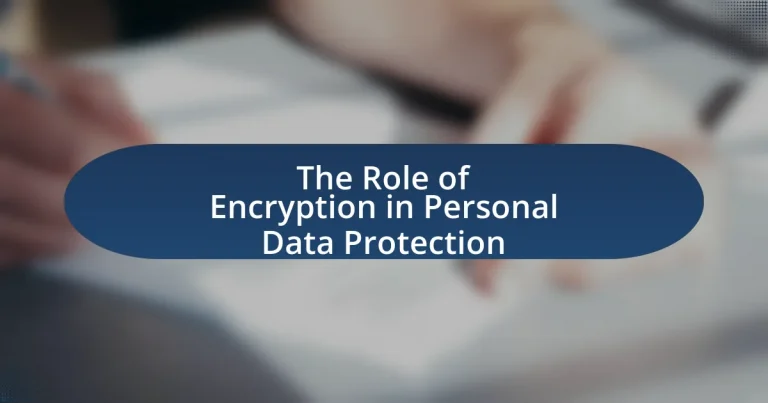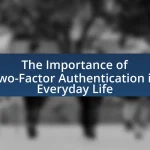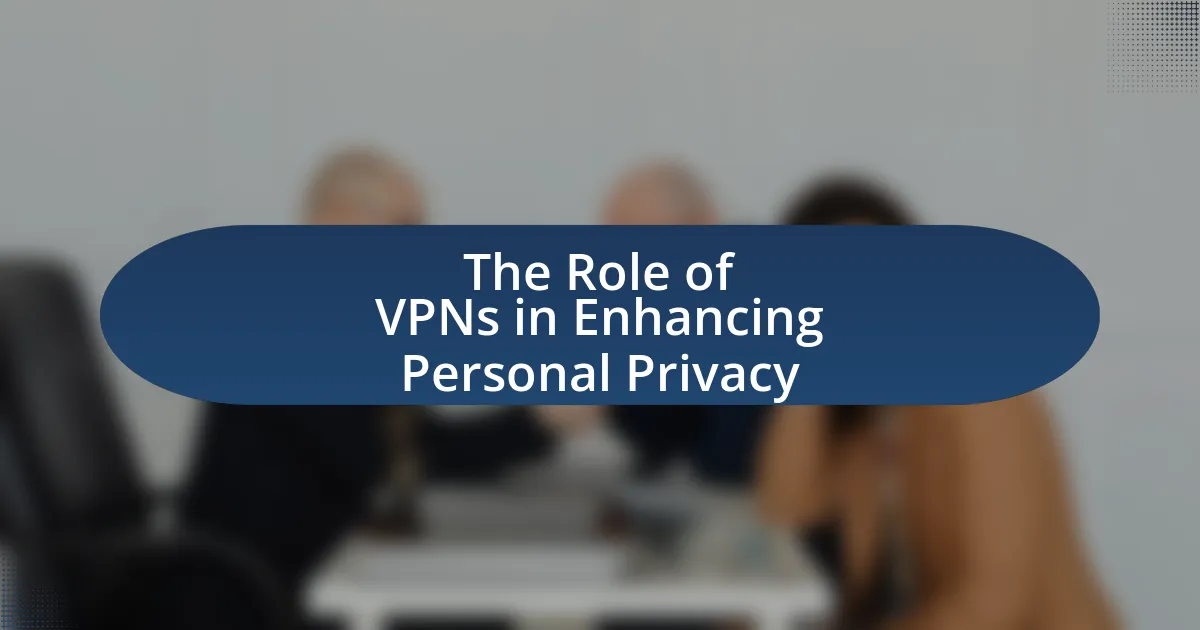Encryption is a vital mechanism for personal data protection, transforming sensitive information into a coded format that is unreadable without the appropriate decryption key. The article explores how encryption safeguards personal data, detailing various methods such as symmetric and asymmetric encryption, and their respective advantages and disadvantages. It emphasizes the importance of encryption in preventing unauthorized access, enhancing user trust, and complying with legal regulations. Additionally, the article outlines practical steps individuals can take to implement encryption effectively, the tools available for personal encryption, and future trends in encryption technology.
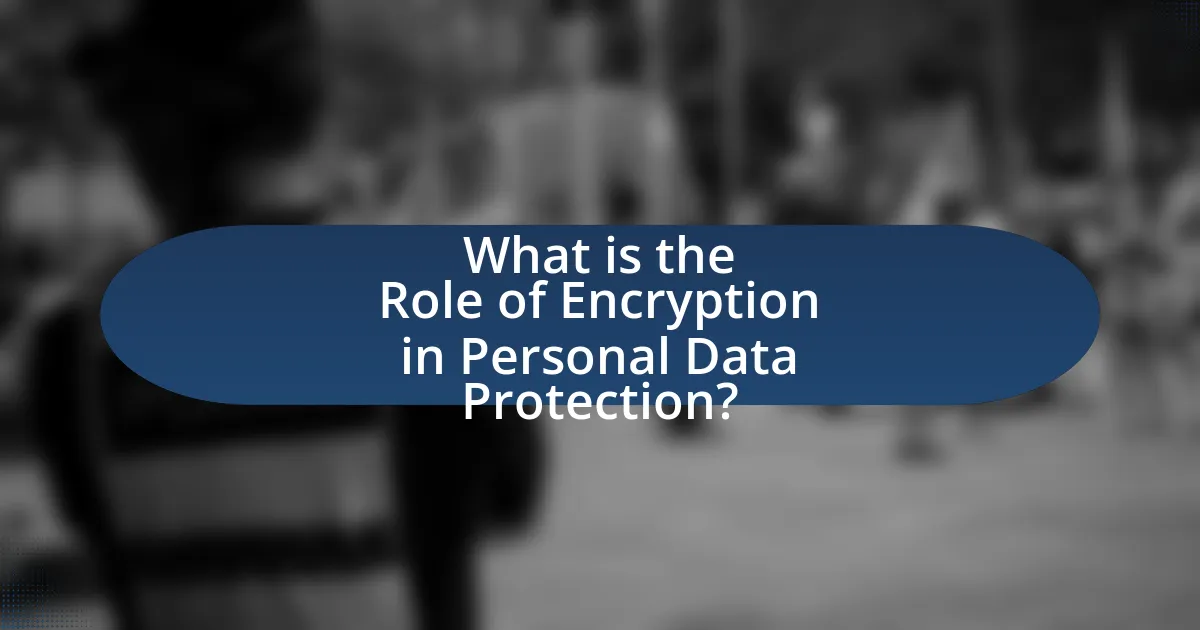
What is the Role of Encryption in Personal Data Protection?
Encryption plays a critical role in personal data protection by converting sensitive information into a coded format that is unreadable without the appropriate decryption key. This process ensures that even if data is intercepted or accessed by unauthorized individuals, it remains secure and confidential. For instance, according to the 2020 Verizon Data Breach Investigations Report, 80% of data breaches involve unencrypted data, highlighting the importance of encryption in safeguarding personal information. By implementing encryption protocols, organizations can significantly reduce the risk of data breaches and enhance the overall security of personal data.
How does encryption safeguard personal data?
Encryption safeguards personal data by converting it into a coded format that is unreadable without the appropriate decryption key. This process ensures that even if unauthorized individuals access the data, they cannot interpret it, thereby protecting sensitive information such as financial records, personal identification, and health information. For instance, the Advanced Encryption Standard (AES) is widely used and recognized for its effectiveness in securing data, as it employs complex algorithms that make it computationally infeasible for attackers to decrypt the information without the key.
What types of encryption methods are commonly used?
Commonly used encryption methods include symmetric encryption, asymmetric encryption, and hashing. Symmetric encryption, such as AES (Advanced Encryption Standard), uses the same key for both encryption and decryption, making it efficient for large data sets. Asymmetric encryption, exemplified by RSA (Rivest-Shamir-Adleman), employs a pair of keys—public and private—for secure data exchange, enhancing security in communications. Hashing methods, like SHA-256 (Secure Hash Algorithm), transform data into fixed-size strings, ensuring data integrity by allowing verification without revealing the original data. These methods are foundational in securing personal data against unauthorized access and breaches.
How does encryption prevent unauthorized access?
Encryption prevents unauthorized access by converting data into a coded format that can only be read by someone with the correct decryption key. This process ensures that even if data is intercepted or accessed by unauthorized individuals, it remains unintelligible and secure. For example, the Advanced Encryption Standard (AES) is widely used to protect sensitive information, and studies show that AES encryption can withstand brute-force attacks due to its complex algorithms. Thus, encryption acts as a critical barrier against unauthorized access, safeguarding personal data effectively.
Why is encryption essential for data privacy?
Encryption is essential for data privacy because it transforms sensitive information into an unreadable format, ensuring that only authorized parties can access it. This process protects personal data from unauthorized access, breaches, and cyberattacks, which are increasingly prevalent in today’s digital landscape. For instance, a 2021 report by Cybersecurity Ventures estimated that cybercrime damages would reach $6 trillion annually, highlighting the critical need for robust security measures like encryption to safeguard personal information.
What are the risks of not using encryption?
The risks of not using encryption include unauthorized access to sensitive data, data breaches, and identity theft. Without encryption, data transmitted over networks is vulnerable to interception by malicious actors, leading to potential exploitation of personal information. For instance, a 2020 report by Verizon indicated that 80% of data breaches involved compromised credentials, often due to unencrypted data being intercepted. Additionally, the lack of encryption can result in legal repercussions for organizations that fail to protect customer data, as regulations like GDPR impose strict penalties for data breaches.
How does encryption enhance user trust?
Encryption enhances user trust by ensuring that sensitive data remains confidential and secure from unauthorized access. When users know their personal information is encrypted, they feel more confident that their data is protected against breaches and misuse. For instance, a study by the Ponemon Institute found that 70% of consumers are more likely to engage with companies that use encryption to safeguard their data. This demonstrates that encryption not only protects data but also fosters a sense of security and reliability among users, ultimately enhancing their trust in organizations that prioritize data protection.
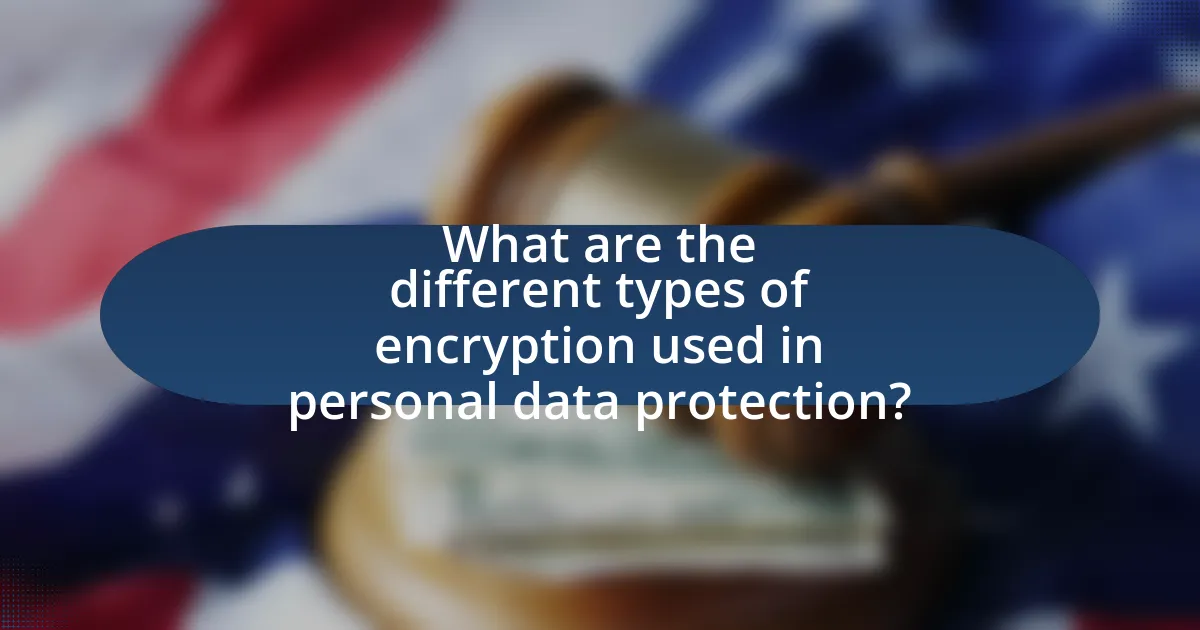
What are the different types of encryption used in personal data protection?
The different types of encryption used in personal data protection include symmetric encryption, asymmetric encryption, and hashing. Symmetric encryption utilizes a single key for both encryption and decryption, making it efficient for large data sets; examples include AES (Advanced Encryption Standard) and DES (Data Encryption Standard). Asymmetric encryption employs a pair of keys—public and private—for secure data exchange, commonly used in protocols like SSL/TLS; RSA (Rivest-Shamir-Adleman) is a widely recognized algorithm in this category. Hashing, while not encryption in the traditional sense, transforms data into a fixed-size string of characters, ensuring data integrity; SHA-256 (Secure Hash Algorithm) is a prominent hashing function. These encryption methods are essential for safeguarding personal data against unauthorized access and breaches.
What is symmetric encryption and how does it work?
Symmetric encryption is a cryptographic method where the same key is used for both encryption and decryption of data. In this process, a plaintext message is transformed into ciphertext using a secret key, and the same key is required to revert the ciphertext back to its original plaintext form. This method relies on the confidentiality of the key; if the key is kept secure, the data remains protected. Symmetric encryption algorithms, such as AES (Advanced Encryption Standard), are widely used due to their efficiency and speed in encrypting large amounts of data. The effectiveness of symmetric encryption is evidenced by its adoption in various applications, including secure communications and data storage, where rapid encryption and decryption are essential.
What are the advantages and disadvantages of symmetric encryption?
Symmetric encryption offers the advantage of speed and efficiency, as it uses a single key for both encryption and decryption, making it faster than asymmetric encryption. This efficiency is particularly beneficial for encrypting large amounts of data quickly. However, the primary disadvantage is the key management issue; if the key is compromised, all data encrypted with that key is at risk, leading to potential security breaches. Additionally, symmetric encryption lacks the non-repudiation feature found in asymmetric encryption, meaning that it does not provide proof of the origin of the data.
In what scenarios is symmetric encryption most effective?
Symmetric encryption is most effective in scenarios where secure communication occurs between parties that share a secret key. This method is particularly advantageous for encrypting large volumes of data quickly due to its efficiency in processing speed compared to asymmetric encryption. For instance, symmetric encryption is commonly used in securing data at rest, such as files on a hard drive or databases, where the same key can be used for both encryption and decryption, ensuring that only authorized users can access the information. Additionally, symmetric encryption is effective in real-time applications like virtual private networks (VPNs) and secure messaging services, where low latency and high throughput are critical. The efficiency of symmetric algorithms, such as AES (Advanced Encryption Standard), which can process data in blocks, further supports its effectiveness in these scenarios.
What is asymmetric encryption and how does it differ from symmetric encryption?
Asymmetric encryption is a cryptographic method that uses a pair of keys: a public key for encryption and a private key for decryption. This contrasts with symmetric encryption, which relies on a single key for both encryption and decryption. In asymmetric encryption, the public key can be shared openly, allowing anyone to encrypt messages, while only the holder of the private key can decrypt them, enhancing security in communication. Symmetric encryption, on the other hand, requires both parties to share the same secret key, which poses a risk if the key is intercepted. The distinct key management in asymmetric encryption provides a more secure framework for protecting personal data.
What are the key components of asymmetric encryption?
The key components of asymmetric encryption are the public key, private key, and the encryption algorithm. The public key is used to encrypt data, allowing anyone to send secure messages, while the private key is kept secret and used to decrypt the messages. The encryption algorithm defines the mathematical procedures for transforming plaintext into ciphertext and vice versa. These components work together to ensure secure communication, as demonstrated by the RSA algorithm, which relies on the mathematical difficulty of factoring large prime numbers to provide security.
How does asymmetric encryption facilitate secure communications?
Asymmetric encryption facilitates secure communications by using a pair of keys: a public key for encryption and a private key for decryption. This method ensures that only the intended recipient, who possesses the private key, can decrypt the message, thereby maintaining confidentiality. For example, when a sender encrypts a message with the recipient’s public key, only the recipient can decrypt it with their corresponding private key, preventing unauthorized access. This system also supports authentication and integrity, as the sender can sign the message with their private key, allowing the recipient to verify the sender’s identity using the sender’s public key.
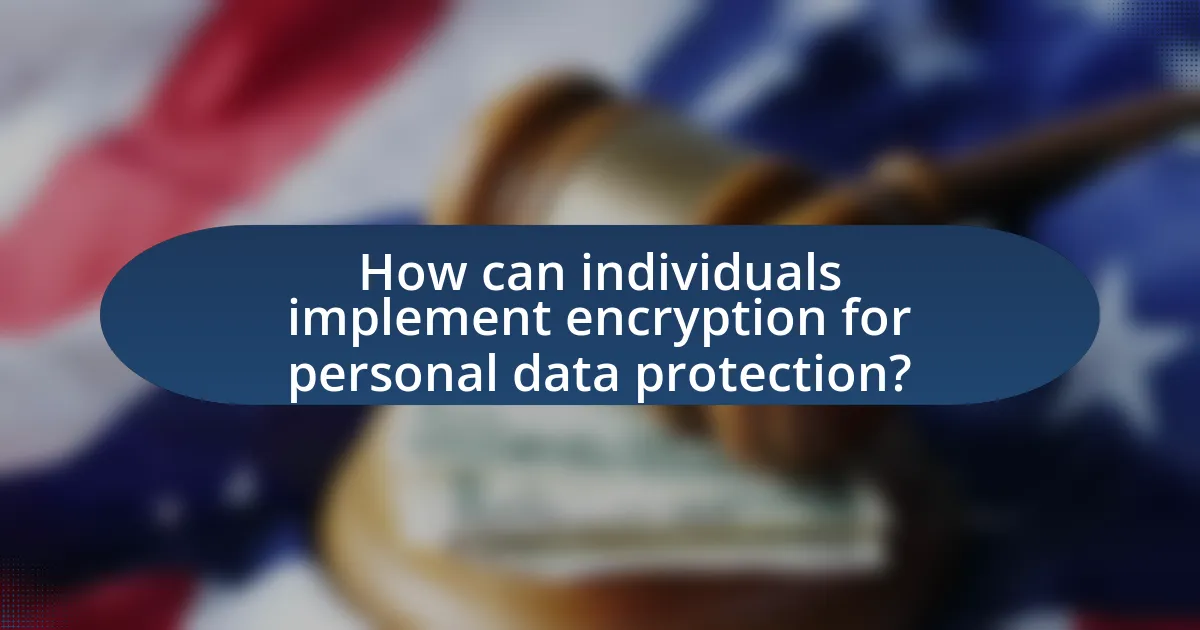
How can individuals implement encryption for personal data protection?
Individuals can implement encryption for personal data protection by using encryption software or built-in operating system features to secure their files and communications. For instance, tools like VeraCrypt or BitLocker allow users to encrypt entire drives or specific files, ensuring that unauthorized access is prevented. Additionally, messaging apps such as Signal or WhatsApp provide end-to-end encryption for secure communication, meaning that only the sender and recipient can read the messages. According to a 2021 report by the Cybersecurity & Infrastructure Security Agency, encryption is a critical measure for safeguarding sensitive information against data breaches and cyberattacks, highlighting its effectiveness in protecting personal data.
What tools and software are available for personal encryption?
Tools and software available for personal encryption include VeraCrypt, BitLocker, AxCrypt, and GnuPG. VeraCrypt is an open-source disk encryption software that provides strong encryption for files and entire drives, making it a popular choice for personal data protection. BitLocker, integrated into Windows, offers full disk encryption to safeguard data on Windows devices. AxCrypt is a user-friendly file encryption software that allows users to encrypt individual files easily. GnuPG, or GNU Privacy Guard, is a free implementation of the OpenPGP standard, enabling users to encrypt and sign their data and communications. These tools are widely recognized for their effectiveness in enhancing personal data security through encryption.
How do these tools vary in terms of usability and security?
Encryption tools vary significantly in usability and security. Usability refers to how easy and intuitive the tools are for users to implement and manage, while security pertains to the strength of the encryption methods used and their effectiveness in protecting data. For instance, user-friendly tools like BitLocker and VeraCrypt offer straightforward interfaces, making them accessible for non-technical users, but may sacrifice some advanced security features. In contrast, tools like OpenSSL provide robust security through complex configurations, which can be challenging for average users to navigate. Research indicates that usability can impact security; if users find a tool too complicated, they may resort to insecure practices, such as using weak passwords or avoiding encryption altogether. Therefore, the balance between usability and security is crucial in selecting encryption tools for personal data protection.
What are the best practices for choosing encryption software?
The best practices for choosing encryption software include evaluating the software’s security standards, ensuring it uses strong encryption algorithms, and verifying its compliance with industry regulations. Security standards such as FIPS 140-2 certification indicate that the software meets government security requirements. Strong encryption algorithms, like AES-256, are essential for protecting sensitive data effectively. Compliance with regulations such as GDPR or HIPAA is crucial for organizations handling personal data, as it ensures that the software adheres to legal requirements for data protection. Additionally, assessing the software’s usability and support options can enhance the overall effectiveness of the encryption solution.
What steps can individuals take to ensure their data is encrypted effectively?
Individuals can ensure their data is encrypted effectively by using strong encryption algorithms, such as AES-256, and employing secure password management practices. Strong encryption algorithms provide a high level of security, as AES-256 is widely recognized for its robustness and is used by government agencies and financial institutions. Additionally, individuals should utilize tools like VPNs and encrypted messaging apps, which offer end-to-end encryption, ensuring that data remains secure during transmission. Regularly updating software and encryption tools is also crucial, as updates often include security patches that protect against vulnerabilities. By following these steps, individuals can significantly enhance the security of their personal data.
How can users regularly update their encryption methods?
Users can regularly update their encryption methods by implementing a schedule for reviewing and upgrading their encryption protocols. This can be achieved by setting reminders to check for updates from encryption software providers, ensuring that they are using the latest versions that include improved algorithms and security patches. Regularly consulting resources such as the National Institute of Standards and Technology (NIST) guidelines can provide users with the latest recommendations on encryption standards, ensuring compliance with best practices. Additionally, users should consider adopting automated tools that facilitate the encryption process and notify them of necessary updates, thereby maintaining robust data protection.
What common mistakes should be avoided when using encryption?
Common mistakes to avoid when using encryption include using weak encryption algorithms, failing to manage encryption keys securely, neglecting to encrypt all sensitive data, and not regularly updating encryption methods. Weak algorithms, such as those with short key lengths, can be easily compromised; for example, the use of DES (Data Encryption Standard) is now considered insecure due to advancements in computational power. Secure key management is crucial, as losing or improperly storing keys can render encrypted data inaccessible. Additionally, not encrypting all sensitive data, including backups, can lead to vulnerabilities; a study by the Ponemon Institute found that 60% of data breaches involved unencrypted data. Finally, regularly updating encryption methods is essential to protect against emerging threats, as outdated algorithms may become susceptible to attacks over time.
What are the future trends in encryption for personal data protection?
Future trends in encryption for personal data protection include the adoption of quantum-resistant algorithms, increased use of homomorphic encryption, and the implementation of decentralized encryption methods. Quantum-resistant algorithms are being developed to safeguard data against potential threats posed by quantum computing, which could break traditional encryption methods. Homomorphic encryption allows computations to be performed on encrypted data without needing to decrypt it, enhancing privacy while enabling data analysis. Decentralized encryption methods, such as those utilizing blockchain technology, are gaining traction as they provide enhanced security and control over personal data by eliminating central points of failure. These trends reflect a growing emphasis on robust data protection mechanisms in response to evolving cyber threats.
How is technology evolving to enhance encryption methods?
Technology is evolving to enhance encryption methods through advancements in quantum computing and machine learning. Quantum computing introduces new algorithms, such as Shor’s algorithm, which can potentially break traditional encryption methods, prompting the development of quantum-resistant algorithms like lattice-based cryptography. Machine learning enhances encryption by improving key management and anomaly detection, allowing for adaptive security measures that respond to emerging threats. For instance, the National Institute of Standards and Technology (NIST) is actively working on post-quantum cryptography standards to ensure data protection against future quantum attacks, demonstrating a proactive approach to evolving encryption technologies.
What role will legislation play in shaping encryption practices?
Legislation will play a crucial role in shaping encryption practices by establishing legal frameworks that dictate how encryption must be implemented and managed. For instance, laws such as the General Data Protection Regulation (GDPR) in the European Union mandate that organizations must use appropriate technical measures, including encryption, to protect personal data. This regulatory requirement influences companies to adopt stronger encryption methods to comply with legal standards, thereby enhancing overall data security. Additionally, legislation can also set penalties for non-compliance, further incentivizing organizations to prioritize robust encryption practices to avoid legal repercussions.
What practical tips can individuals follow to enhance their personal data protection through encryption?
Individuals can enhance their personal data protection through encryption by using strong, unique passwords for encrypted files and applications. This practice ensures that unauthorized users cannot easily access sensitive information. Additionally, individuals should utilize end-to-end encryption for messaging apps, which secures communications from sender to recipient, preventing interception. Regularly updating encryption software is crucial, as it protects against vulnerabilities that could be exploited by cybercriminals. Furthermore, individuals should consider encrypting their entire hard drive, which safeguards all data stored on the device, making it inaccessible without proper authentication. According to a 2021 report by the Cybersecurity & Infrastructure Security Agency, implementing these encryption strategies significantly reduces the risk of data breaches and unauthorized access.
